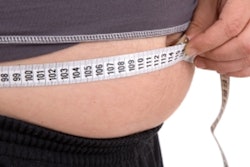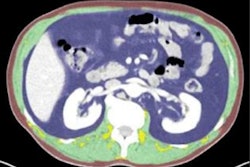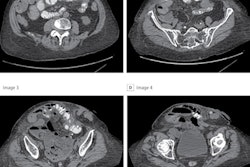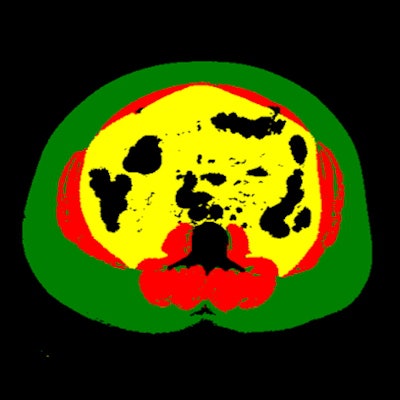
Body composition metrics automatically calculated from abdominal CT exams by an artificial intelligence (AI) algorithm are significantly associated with patient risk for future major cardiovascular events, according to a Wednesday morning presentation at the RSNA 2020 virtual meeting.
After testing their deep-learning model on abdominal CT exams from over 12,000 patients, researchers from Brigham and Women's Hospital in Boston found that its visceral fat measurements were independently associated with subsequent myocardial infarction and subsequent stroke. Body mass index (BMI), however, was not.
"This work shows the promise of AI systems to add value to clinical care by extracting new information from existing imaging data," said presenter Dr. Kirti Magudia, PhD, in a statement from the RSNA. "The deployment of AI systems would allow radiologists, cardiologists and primary care doctors to provide better care to patients at minimal incremental cost to the health care system."
Magudia, currently an abdominal imaging and ultrasound fellow at the University of California, San Francisco, shared the results of research performed while she was a radiology resident at Brigham and Women's Hospital and part of a multidisciplinary group that developed the deep-learning algorithm.
Shortcomings of BMI
Body composition is largely thought of as a crude surrogate for BMI, but that measure has its shortcomings. Patients with the same BMI can have markedly different ratios of subcutaneous fat to skeletal muscle, Magudia said.
Subcutaneous fat, visceral fat, and skeletal muscle can be visualized on a single axial CT slice from the L3 spine vertebra, but it's time-intensive and costly to manually measure these individual areas. Consequently, utilization of this technique has been limited to small cohorts and well-funded research studies, she said.
To help, the group developed a deep learning-based automated body composition analysis tool. With this approach, axial abdominal CT series are selected via series selection logic from abdominal CT studies in their PACS.
After a slice selection network is applied to select the L3 CT slice, a segmentation network then creates a segmentation image mask, which can be used to calculate body composition areas, Magudia said. During validation, the model's automated segmentation results correlated very highly (r = 0.99) with radiologist segmentations for all body compartments.
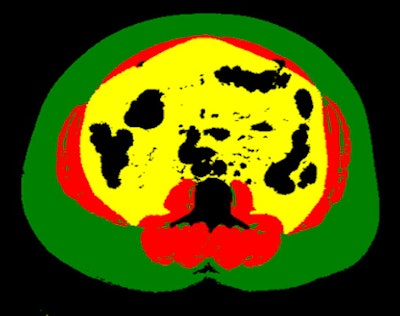 Example of body composition analysis of an abdominal CT slice with subcutaneous fat in green, skeletal muscle in red, and visceral fat in yellow. Image and caption courtesy of Dr. Kirti Magudia, PhD, and the RSNA.
Example of body composition analysis of an abdominal CT slice with subcutaneous fat in green, skeletal muscle in red, and visceral fat in yellow. Image and caption courtesy of Dr. Kirti Magudia, PhD, and the RSNA.The researchers next used the algorithm to retrospectively determine body composition areas for all outpatient abdominal CT exams performed at Partners HealthCare in Boston in 2012. After subjects with major cardiovascular disease or cancer were excluded, a total of 12,128 patients were included in the study.
Automated analysis
Automated analysis was performed on the first abdominal CT scan acquired from each subject in 2012. Quality assurance analysis showed that the algorithm had a 2.5% overall segmentation error rate, Magudia said.
After race-, sex-, and age-specific reference curves were used to determine demographic-specific z-scores for each parameter, the researchers then evaluated the association between composition z-scores and subsequent myocardial infarction and stroke. Patients were divided into four quartiles for each normalized body composition parameter.
The researchers performed univariate analysis, as well as multivariate analysis that encompassed all body composition parameters and weight, height, and cardiovascular risk factors.
Association with risk
For visceral fat, individuals in the fourth quartile -- those with the highest proportion of visceral fat area -- were more likely to have future myocardial infarctions following the abdominal CT scan than patients in other quartiles (see figure 1).
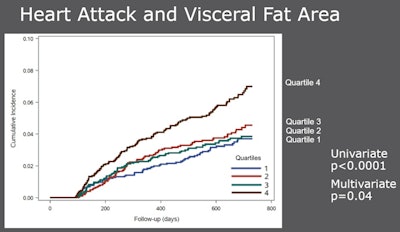 Figure 1. Chart courtesy of Dr. Kirti Magudia, PhD, and the RSNA.
Figure 1. Chart courtesy of Dr. Kirti Magudia, PhD, and the RSNA.Meanwhile, the first quartile of patients was protected against stroke in the years following the abdominal CT exam (see figure 2).
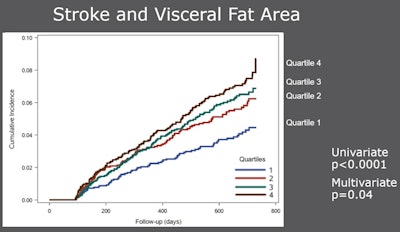 Figure 2. Chart courtesy of Dr. Kirti Magudia, PhD, and the RSNA.
Figure 2. Chart courtesy of Dr. Kirti Magudia, PhD, and the RSNA.However, BMI was not associated with future heart attack or stroke, according to the researchers.
"These results demonstrate that precise measures of body muscle and fat compartments achieved through CT outperform traditional biomarkers for predicting risk for cardiovascular outcomes," Magudia said in a statement.






